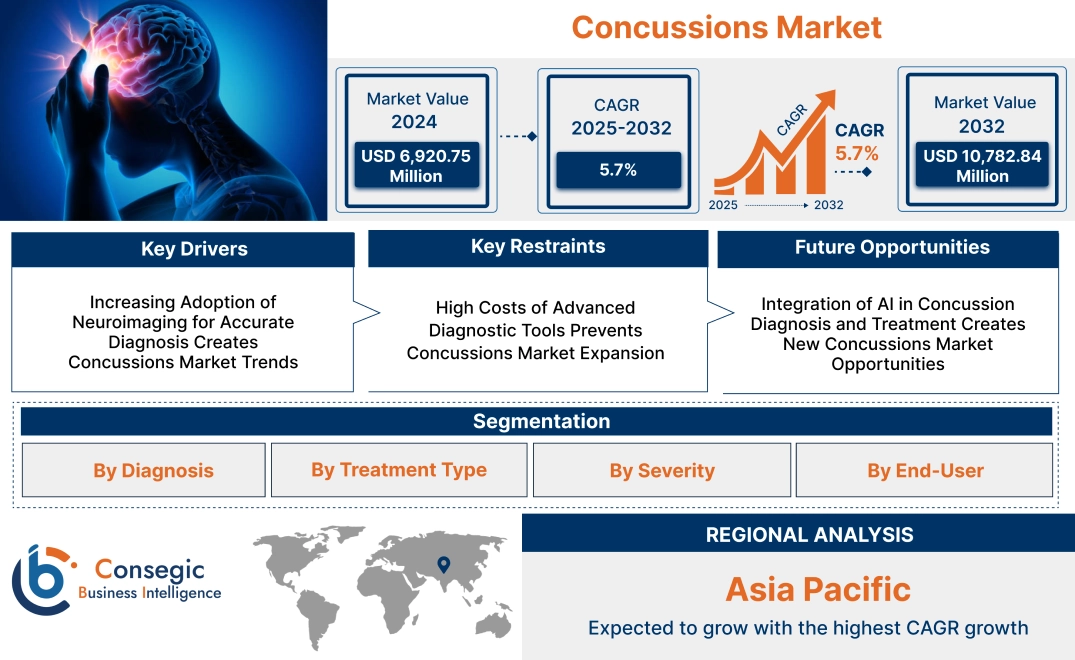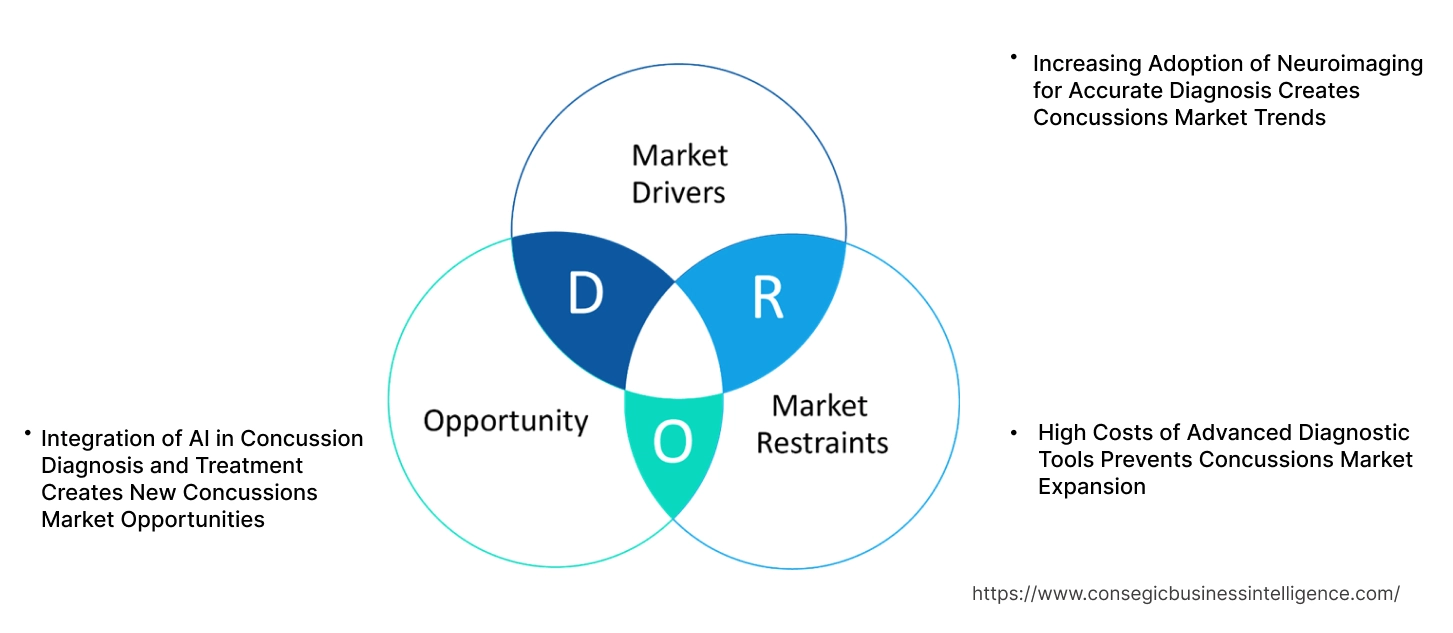Concussions Market Size:
Concussions Market size is estimated to reach over USD 10,782.84 Million by 2032 from a value of USD 6,920.75 Million in 2024 and is projected to grow by USD 7,191.92 Million in 2025, growing at a CAGR of 5.7 % from 2025 to 2032.
Concussions Market Scope & Overview:
Concussions are mild traumatic brain injuries resulting from external force, leading to temporary disruption in brain function. They are commonly associated with sports injuries, accidents, and falls. Key characteristics include symptoms like headache, dizziness, memory loss, and difficulty concentrating. Diagnostic tools such as imaging systems, neurological assessments, and symptom monitoring aid in accurate detection.
Treatment options focus on symptom management and brain recovery. These include medications, rest protocols, and cognitive rehabilitation therapies. Preventive measures involve protective equipment and educational programs for risk mitigation. Applications are widespread across sports organizations, healthcare facilities, and military units. End-use industries include hospitals, diagnostic centers, rehabilitation clinics, and research institutions focused on neurological health.
Concussions Market Dynamics - (DRO) :
Key Drivers:
Increasing Adoption of Neuroimaging for Accurate Diagnosis Creates Concussions Market Trends
Neuroimaging techniques, including MRI and CT scans, play a crucial role in diagnosing concussions, offering detailed visualization of brain injuries. These methods enable healthcare providers to identify subtle structural abnormalities and monitor recovery. For instance, advancements in functional MRI have facilitated the assessment of blood flow and neural activity, enhancing diagnostic precision.
The increasing reliance on such technologies in clinical settings boosts their adoption, leading to greater demand for neuroimaging solutions in concussion diagnosis. Therefore, the widespread adoption of neuroimaging techniques drives the concussions market growth.
Key Restraints:
High Costs of Advanced Diagnostic Tools Prevents Concussions Market Expansion
The costs associated with advanced diagnostic tools such as neuroimaging equipment, including MRI and CT scanners, remain prohibitively high for many healthcare providers. These expenses also extend to installation, maintenance, and operational training. Additionally, reimbursement policies for concussion diagnostics vary significantly, further complicating accessibility.
This financial burden particularly affects smaller healthcare facilities and patients in low-income regions, limiting the adoption of advanced concussion diagnostic tools. Consequently, high costs impede the widespread implementation of these solutions, hindering the concussions market growth.
Future Opportunities :
Integration of AI in Concussion Diagnosis and Treatment Creates New Concussions Market Opportunities
The integration of artificial intelligence (AI) in concussion diagnosis and treatment offers significant potential for innovation in the near future. AI-powered algorithms can analyze complex neuroimaging data to identify patterns associated with concussions, improving diagnostic accuracy. Additionally, AI tools can assist in creating personalized treatment plans by evaluating patient-specific data.
For example, machine learning models are being developed to predict recovery timelines and optimize rehabilitation strategies. As AI adoption accelerates in healthcare, its application in concussion management is expected to create substantial concussions market trend opportunities.
Concussions Market Segmental Analysis :
By Diagnosis:
Based on diagnosis, the market is segmented into neurological examination, imaging tests, CT scans, MRI scans, cognitive testing, and blood biomarkers.
Neurological Examination accounted for the largest revenue in concussions market share in 2024.
- Neurological examination remains the primary diagnostic approach for assessing concussions, enabling clinicians to evaluate motor function, sensory response, and reflexes effectively.
- This diagnostic method is widely used across healthcare settings due to its non-invasive nature and immediate results.
- Neurological assessments help to identify cognitive impairments, balance issues, and other symptoms associated with concussions, aiding in prompt decision-making for further testing or treatment.
- Therefore, according to concussions market analysis, accessibility and cost-effectiveness contribute significantly to its dominance in the market.
Blood Biomarkers are anticipated to register the fastest CAGR during the forecast period.
- Blood biomarkers are emerging as an innovative diagnostic tool for concussions, offering precision in identifying brain injury at a molecular level.
- These biomarkers enable early detection and monitoring of concussions, particularly in mild cases where symptoms may not be visibly apparent.
- The growing focus on personalized medicine and advancements in biomarker technology are propelling the adoption of this diagnostic method.
- Thus, according to concussions market analysis, increasing clinical research validating the efficacy of blood biomarkers further accelerates their concussions market trend.
By Treatment Type:
Based on treatment type, the market is segmented into medications (pain relievers, anti-inflammatory drugs, antidepressants, and anti-seizure medications) and rehabilitation therapies (physical therapy, cognitive therapy, and speech therapy).
Medications accounted for the largest revenue in concussions market share in 2024.
- Medications play a critical role in managing concussion symptoms, including headaches, dizziness, and mood disturbances.
- Pain relievers and anti-inflammatory drugs are widely prescribed to alleviate acute symptoms, ensuring patient comfort.
- The demand for tailored pharmaceutical solutions to address post-concussion syndrome is driving revenue in this segment.
- Therefore, according to market analysis, availability of generic and branded formulations further supports widespread adoption across different healthcare systems.
Rehabilitation Therapies are anticipated to register the fastest CAGR during the forecast period.
- Rehabilitation therapies, including physical, cognitive, and speech therapy, are increasingly recognized for their role in comprehensive concussion recovery.
- These therapies address long-term effects such as cognitive impairments, balance issues, and speech difficulties, enabling better patient outcomes.
- The emphasis on personalized care plans and multidisciplinary approaches is expanding the utilization of rehabilitation services.
- Thus, according to market analysis, rising awareness among patients and healthcare providers about non-pharmaceutical treatment options fosters growth in this segment.
By Severity:
Based on severity, the market is segmented into mild concussion, moderate concussion, and severe concussion.
Mild Concussion accounted for the largest revenue share in 2024.
- Mild concussions are the most frequently reported, particularly in sports, workplace injuries, and minor accidents.
- They are often managed in outpatient settings, ensuring wide accessibility of diagnosis and treatment options.
- Therefore, according to market analysis, public health initiatives and guidelines focusing on early recognition and management of mild concussions further enhance this segment's revenue share.
Severe Concussion is anticipated to register the fastest CAGR during the forecast period.
- Severe concussions require comprehensive management, including hospitalizations and long-term therapies, contributing to the high expenditure in this segment.
- Growing advancements in acute care, coupled with improved diagnostic capabilities for identifying severe brain injuries, are driving this segment's growth.
- Thus, according to market analysis, rising awareness about the potential long-term consequences of severe concussions is encouraging timely and intensive treatment approaches.
By End-User:
Based on end-user, the market is segmented into hospitals & clinics, rehabilitation centers, and sports medicine centers.
Hospitals & Clinics accounted for the largest revenue share of 43.65% in 2024.
- Hospitals and clinics are the primary points of care for concussion management, offering advanced diagnostic tools and multidisciplinary treatment options.
- The availability of specialized neurology departments and emergency care ensures comprehensive management of concussion cases.
- Therefore, according to market analysis, increased patient admissions for concussions in these settings contribute to the dominance of this segment.
Sports Medicine Centers are anticipated to register the fastest CAGR during the forecast period.
- Sports medicine centers are witnessing increasing demand due to the high prevalence of sports-related concussions among athletes.
- These centers specialize in tailored care, including immediate diagnosis, treatment, and rehabilitation, ensuring rapid recovery for athletes.
- Thus, according to market analysis, growing investments in sports healthcare infrastructure and awareness campaigns on athlete safety further propel this segment's growth.
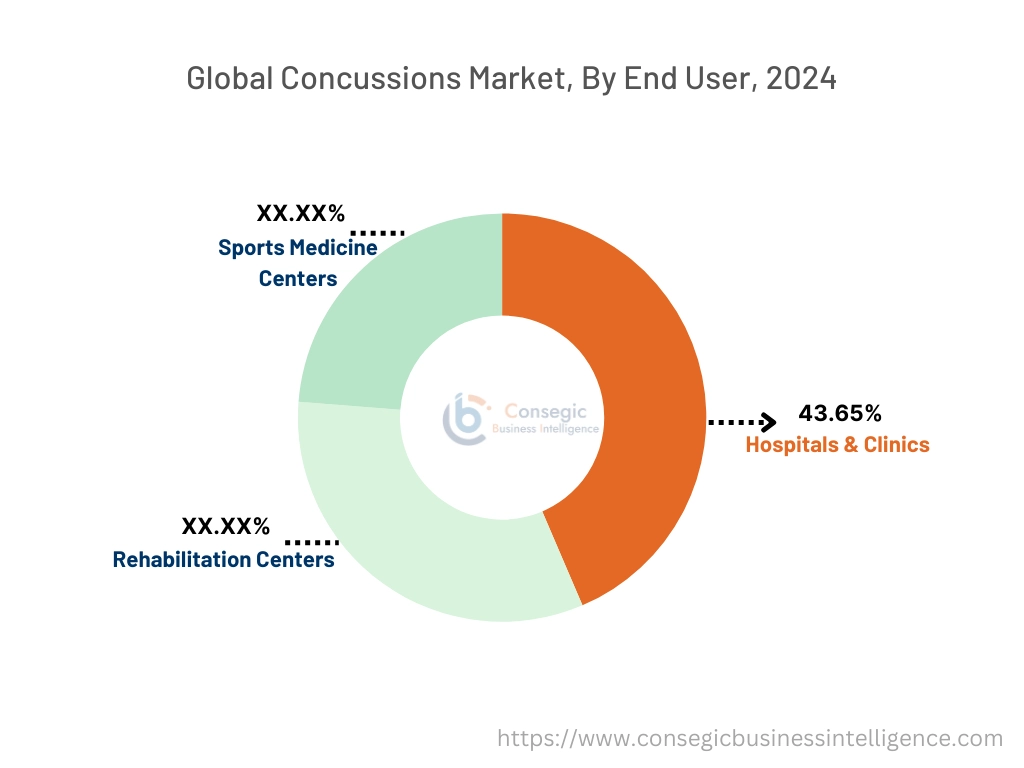
Regional Analysis:
The regional segment includes North America, Europe, Asia Pacific, Middle East and Africa, and Latin America.
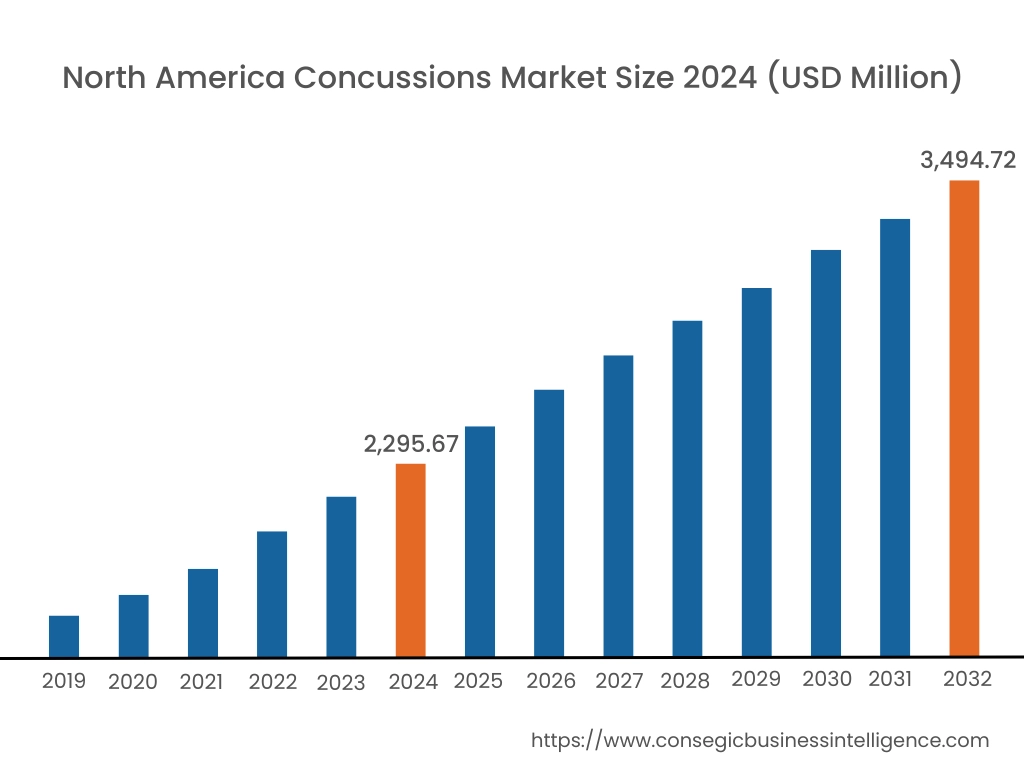
In 2024, North America was valued at USD 2,295.67 Million and is expected to reach USD 3,494.72 Million in 2032. In North America, the U.S. accounted for the highest share of 72.40% during the base year of 2024. North America holds the largest share of the concussions market, driven by heightened awareness of the risks associated with concussions in sports, military, and occupational settings. The United States leads the region with extensive research initiatives, strong healthcare infrastructure, and a focus on concussion prevention and treatment. Growing awareness campaigns and improved diagnosis rates, along with increased funding for concussion-related studies, support the market. The prevalence of concussions in contact sports, particularly football, contributes significantly to concussions market expansion in this region.
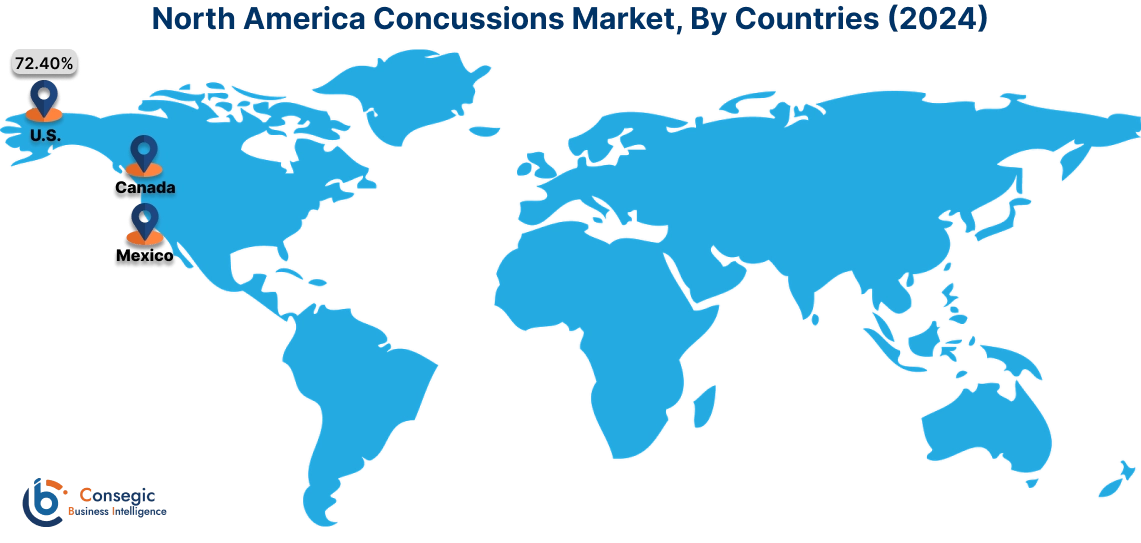
In Asia Pacific, the market is experiencing the fastest growth with a CAGR of 6.1% over the forecast period. The Asia-Pacific region is witnessing steady development in the concussions market, with countries like Japan, China, and India focusing on improving healthcare systems and awareness about concussion risks. Japan and Australia have implemented significant initiatives to manage concussions in sports, especially in rugby and soccer. In contrast, China and India face challenges related to limited awareness and healthcare infrastructure. However, the increasing participation in sports and the rising incidence of concussions are gradually creating a larger market for concussion treatment and management in the region.
Europe demonstrates a well-established market for concussion management, with countries like the United Kingdom, Germany, and France leading the way in research and treatment options. European countries are focused on improving sports-related concussion protocols and have implemented policies aimed at reducing concussion risks in youth sports. Rising sports participation and initiatives by organizations like UEFA and the European Commission to address concussion safety contribute to the concussions market demand. The region also benefits from strong healthcare systems, with many countries investing in concussion awareness, prevention, and treatment programs.
The Middle East and Africa region is still in the early stages of developing a structured concussion market. Awareness levels are relatively low, and healthcare infrastructure is underdeveloped in many African countries. However, countries in the Middle East, particularly the UAE and Saudi Arabia, are investing in healthcare advancements and starting to focus on concussion management, particularly in sports like football. In Africa, the market remains limited due to economic constraints, but growing sports popularity and increasing investments in healthcare are expected to improve the market landscape in the coming years.
In Latin America, the concussions market is expanding as sports, particularly soccer, continue to grow in popularity. Countries like Brazil, Argentina, and Mexico are increasingly focusing on improving concussion management protocols in professional and youth sports. However, the market is hindered by limited healthcare access, lack of awareness, and insufficient resources for concussion diagnosis and treatment. Governments and healthcare organizations are beginning to recognize the importance of concussion management, which is likely to improve the market outlook in the region over time.
Top Key Players and Market Share Insights:
The Global Concussions Market is highly competitive with major players providing products and servicesto the national and international markets. Key players are adopting several strategies in research and development (R&D), product innovation, and end-user launches to hold a strong position in the Global Concussions Market. Key players in the Concussions industry include-
- Abbott Laboratories (United States)
- Medtronic PLC (Ireland)
- ImPACT Applications, Inc. (United States)
- Cognizant Technology Solutions Corporation (United States)
- Helmholtz Institute (Germany)
- Johnson & Johnson (United States)
- Stryker Corporation (United States)
- Zimmer Biomet Holdings, Inc. (United States)
- Becton, Dickinson and Company (United States)
- BrainScope Company, Inc. (United States)
Recent Industry Developments :
Partnerships & Collaborations:
- In September 2024, FIFA and the World Health Organization launched the "Suspect and Protect: No Match is Worth the Risk" campaign. This global initiative focuses on raising awareness about the risks of traumatic brain injuries and provides resources to promote player safety in football.
Concussions Market Report Insights :
| Report Attributes | Report Details |
| Study Timeline | 2019-2032 |
| Market Size in 2032 | USD 10,782.84 Million |
| CAGR (2025-2032) | 5.7% |
| By Diagnosis |
|
| By Treatment Type |
|
| By Severity |
|
| By End-User |
|
| By Region |
|
| Key Players |
|
| North America | U.S. Canada Mexico |
| Europe | U.K. Germany France Spain Italy Russia Benelux Rest of Europe |
| APAC | China South Korea Japan India Australia ASEAN Rest of Asia-Pacific |
| Middle East and Africa | GCC Turkey South Africa Rest of MEA |
| LATAM | Brazil Argentina Chile Rest of LATAM |
| Report Coverage |
|
Key Questions Answered in the Report
How big is the Concussions Market? +
In 2024, the Concussions Market was USD 6,920.75 million.
What will be the potential market valuation for the Concussions Market by 2032? +
In 2032, the market size of Concussions Market is expected to reach USD 10,782.84 million.
What are the segments covered in the Concussions Market report? +
The diagnosis, treatment type, severity, and end-user are the segments covered in this report.
Who are the major players in the Concussions Market? +
Abbott Laboratories (United States), Medtronic PLC (Ireland), Johnson & Johnson (United States), Stryker Corporation (United States), Zimmer Biomet Holdings, Inc. (United States), Becton, Dickinson and Company (United States), BrainScope Company, Inc. (United States), ImPACT Applications, Inc. (United States), Cognizant Technology Solutions Corporation (United States), Helmholtz Institute (Germany) are the major players in the Concussions market.
